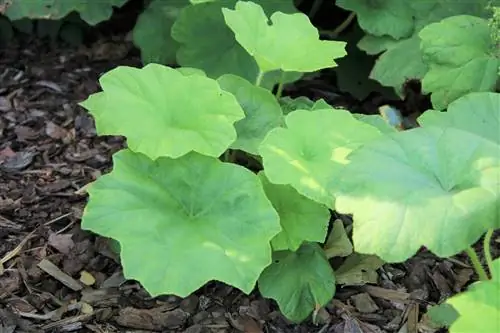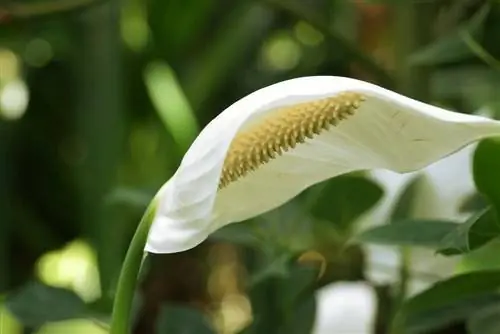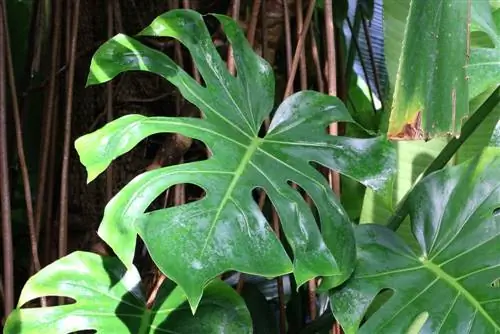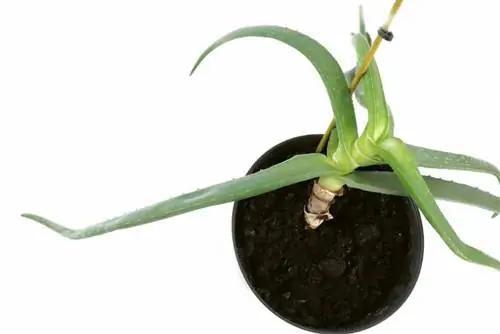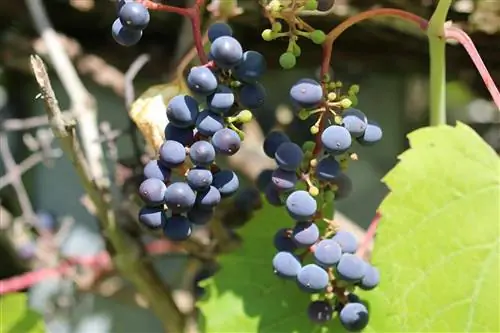- Author admin [email protected].
- Public 2023-12-17 03:39.
- Last modified 2025-06-01 06:48.
With mighty umbrella leaves on powerful stems, the table leaf colonizes delicate locations in the garden where other plants only thrive poorly. Along the swampy bank of the pond or stream, the sprawling foliage plant provides lush abundance where previously there was a damp, cool emptiness. While a shady spot in the perennial bed has previously given hobby gardeners a headache, the Astilboides tabularis feels particularly at home here. The following lines reveal exactly which location the table leaf wants and how it is planted and cared for.
Profile
- Saxifragaceae plant family
- Species and genus: Table leaf (Astilboides tabularis)
- native to northern China and Korea
- perennial ornamental foliage plant
- Growth height 70 to 100 centimeters
- Leaf diameter up to 90 centimeters
- creamy white panicle blossom in June
- deciduous and hardy
Location and soil conditions
A central function in the successful cultivation of an Astilboides tabularis is the choice of location. If you make the right choice here, care will be limited to a minimum.
- partially shady to shady location
- moist soil without permanent waterlogging
- nutrient-rich, humus, cool
- ideal is a pH value of 5 to 6.5
Therefore, look for a planting site along trees, flowing or standing water. Since the table leaf prefers slightly acidic soil, a neighborhood with ericaceous plants is also an option.
Tip:
The table leaf is very faithful to its location and generally does not tolerate transplanting.
Plants
Once the decision has been made regarding the location, nothing stands in the way of successful planting. The table leaf can easily be placed in the ground all year round as long as it doesn't freeze. The saxifrage plant is grateful for careful preparation of the soil. Since it grows very slowly, thorough removal of weeds should ensure that it does not immediately become overgrown. During this work, use the time to soak the root ball of the young plant in a container with water.
- Dig a planting hole with twice the volume of the root ball.
- Enrich the excavation with mature compost and horn shavings.
- Unpot the table leaf and place it in the middle of the planting pit.
- After planting, press the substrate well and water it.
A mulch layer of leaves, grass or compost supports the foliage plant during the growing phase. If additional specimens are to be planted, a planting distance of 100 cm is appropriate.
Watering and fertilizing
The site conditions determine the frequency of watering. The board sheet wants to be permanently moist and not dry out if possible. Since the plant prefers a low-lime environment, collected rainwater is ideal as irrigation water. If available, pond water can also be used for this purpose. No great effort is made to ensure adequate nutrient supply:
- During budding, the table leaf receives a long-term fertilizer.
- Alternatively, add compost from time to time throughout the growing season.
Cutting
The spent panicles can be cleaned out in July if necessary. They are not important for the propagation of an Astilboides tabularis, as the underground rhizome takes over this task. In autumn, the withered leaves can be cut off close to the ground. Wait until the foliage has completely changed color to carry out this care measure. During this time, the rhizome absorbs all remaining nutrients to prepare for the coming winter and to build up reserves for the next season.
Wintering
The board sheet is designed to be so durable that it can withstand temperatures down to -18 degrees Celsius. If the withered leaves are cut in autumn, light winter protection is still advisable. If you pile up leaves, soil, sticks or straw over the root area, this measure is completely sufficient.
Propagate
If more specimens of this gem are desired, various propagation options are available to choose from.
Division
You can tackle this uncomplicated method of breeding in the spring. The table leaf should be 3-5 years old and well established in the location. The root area is excavated over a wide area and divided into two or more segments with a sharp spade. Each section is immediately planted at the new location and cared for like an adult Astilboides tabularis.
Root cuttings
Since the table leaf develops a thick, fleshy rhizome, it can be propagated using root cuttings. This procedure is a little more complex than division; However, it is useful if you are working towards a larger number of plants.
- Cut off several well-developed roots from the mother plant.
- Cut each root into 5-10 cm thick slices.
- A straight cut is made at the base and an oblique cut is made on the opposite side.
- Fill cultivation pots with nutrient-poor substrate.
Place the prepared root cuttings in the soil with the just cut end facing down. The upper end is flush with the substrate surface. This is followed by a thin layer of sand. Placed in a partially shaded, cool place, wait for the roots to develop. Only when the first shoots appear at the tip is the young table leaf watered.
Sowing
The very fine seeds have an amazing germination ability. It is therefore ideal for easy propagation in the hobby garden. A small pot is filled and moistened with peat sand, coconut fibers or commercial seed soil. Then scatter the seeds, which, as light germinators, are only pressed on and not sifted over. At an average temperature of 20 °C in a partially shaded place, germination begins within 10 to 14 days. The seedlings are transplanted into individual pots from a height of 10 to 15 cm. Once the young plants have developed their own root system, they can be planted outdoors. Tip: The very fine seeds are easier to spread if they are mixed with a little bird sand.
Beautiful planting partners
In order to survive alongside the dominant habit of an Astilboides tabularis, only a few garden plants are suitable. The following planting partners have proven to be suitable so far:
- Japanese ostrich fern (Matteuccia orientalis)
- Gold-edged Japanese sedge (Carex morrowii 'Aureovariegata')
- Epimedium x perralchicum 'Frohnleiten')
- Goldscale Fern (Dryopteris affinis)
- Forest lady fern (Athyrium filix-femina)
In particular, ferns of all kinds can be combined with the table leaf to create effective structures. Both types of plants have similar requirements in terms of location and care.
What you should know about the table sheet in brief
The decorative foliage plant table leaf fills problematic corners in the garden with a powerful habit characterized by huge, round leaves. The appearance is crowned with a pretty creamy white panicle flower in summer. As long as the location is not too bright and the soil is moist, cool and acidic, the saxifrage plant feels comfortable for many years. This applies to tricky locations near ponds or streams, under trees and along the edges of trees. If you choose the right location, the maintenance effort is limited to a little watering in dry conditions and a dose of compost every few weeks. Even when it comes to propagation, the Astilboides tabularis is uncomplicated, as the work is done quickly by dividing, root cuttings or sowing.
Features & Care Instructions
- In dry, hot years, the leaves of the table leaf die much faster than in wet years. They can work well into autumn.
- They reach a diameter of 90 cm and sometimes even more. The petioles are also lush, long and strong. All of this makes for an impressive look.
- With a suitable location and slightly higher humidity, the table leaf hardly needs any care.
- The plants are ideally placed at the edge of the water that is not too wet.
- The most striking feature of the table leaf is its large, umbrella-like leaves. On their tall, strong stems they are an impressive eye-catcher.
- However, the astilbe-like inflorescence, a white, richly flowering, slightly overhanging raceme, is also not to be despised.
- The table leaf is well suited for moist, cool, humus-rich, nutrient-rich soils. It is a great bank plant, but does not like waterlogging.
- The perennial sprouts late. It takes several years to fully develop. Strong sunlight can cause burns on the leaves.
- Then the plant doesn't look so great overall.
Tip:
Otherwise it should be noted that the table leaf works well as a solitaire or in small tuffs with one to three, a maximum of five plants. The table leaf is a long-lived plant. It may not be implemented. In optimal locations, this plant requires almost no care.
board sheet: profile
- Species/family: belongs to the saxifrage family (Saxifragaceae)
- Care effort: very low, one of the plants that prefer to be left alone
- Flowering time: June to July with astilbe-like only much smaller, slightly overhanging flower panicles consisting of many small white or purple flowers
- Foliage: very large, ornamental, shield-shaped leaves in fresh green sitting on long stems
- Growth: broad and spreading growth with clumps of leaves on a tuberous earth stem, spreads itself through rhizomes
- Height: depending on the variety 70 to 150 cm
- Location: semi-shaded to shady. Nutrient-rich and slightly moist soil, loves high humidity
- Planting time: any time as long as the ground is not frozen
- Cut: not required
- Partner: Solitaire
- Propagation: Rhizomes can be removed and replanted
- Care: water when it is dry, but tolerates moisture and drought well, pamper with compost or slow-release fertilizer in spring, but grows well even without fertilization
- Overwintering: hardy, but is grateful for winter protection with leaves, brushwood or mulch
- Illnesses: problem-free
- Well-known variety: “Opal” - height 70 cm, is particularly noticeable due to its large, striking silvery violet flowers

